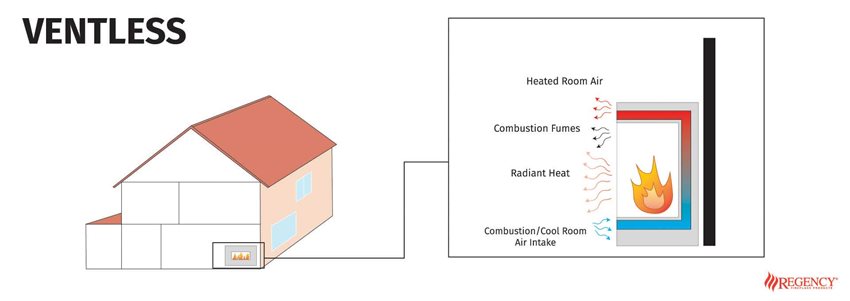What are Ventless Fireplaces?
Ventless fireplaces release the emissions of their burn, including noxious gases such as nitrous dioxide and carbon monoxide, inside the home instead of outside the home like a direct vent fireplace. Ventless fireplaces use interior air for combustion, which includes anything present in the air and on the burner and release all emissions inside the room they operate – dramatically decreasing the air quality you breathe.

Types of Fireplace Venting
There are several different types of venting that can be used with a fireplace, below is a quick explainer of how they differ.
Direct Vent gas fireplaces use outside air for combustion and release all emissions outside the home in a sealed system.
Natural Vent gas fireplaces (B-Vent) use air from within the home for combustion and release emissions outside the home.
Ventless fireplaces use air from within the home and release emissions within the home – resulting in poor air quality and potential health risks.
Are Ventless Gas Fireplaces Safe?
Ventless gas fireplaces emit dangerous and noxious gasses into the room they are operating. Without proper ventilation and safety systems in place there can be serious health risks associated with burning gas in a ventless fireplace. Ventless fireplaces produce small amounts of nitrous dioxide and carbon monoxide which can be deadly in large doses. The CDC warns against exposure of any level of carbon monoxide, stating that up to 500 people die per year due to accidental carbon monoxide poisoning
In order to be used safely ventless fireplaces require carbon monoxide detectors and automatic shutoff valves that measure the oxygen levels in a room. In addition to carbon monoxide, ventless fireplaces also produce a high levels of water vapor. The increased level of water vapor in the home will increase humidity, increasing the risk of mould growth.
Benefits of Ventless Fireplaces
The following are some of the benefits of ventless fireplaces:
- No ventilation required
- No venting means less construction, easier to install in apartments, and a reduction in material costs.
- Great source of heating
- Produce a comparable amount of heat to traditional vented fireplaces
- Relatively Inexpensive
- Less material cost, no need for venting and minimal installation required
Drawbacks of Ventless Fireplaces
The following are drawbacks of ventless fireplaces:
- Release of dangerous gasses
- Carbon monoxide & Nitrous Dioxide
- Dangerous if not managed correctly and negative long-term effects
- Excessive levels of carbon dioxide
- Produces high levels of green-house gasses
- Sooting on the walls, ceiling, and furniture
- Darkening and potential damage to furniture, walls, and ceilings
- Moisture & humidity build-up
- Heightened risk of mould and other moisture born issues
- Reduction of oxygen in small spaces
- Heightened risk of air quality and oxygen level issues
Modern Ventless Fireplaces for Apartments, Units, & Townhouses
Instead of using combustible fuel without any venting why not consider a modern electric fireplace? Electric fireplaces are ventless and do not release any emissions into your home. Heat from electric fireplace is generated from an internal electric heater and the flames are generated using LEDs. Electric fireplaces are the best way to add the warmth, comfort, and ambiance of a fireplace when venting is not an option.
Gazco’s lineup of modern electric fireplaces uses Chromalight LED technology and a 3-dimensional firebox to generate flames so real, you won’t believe they are electric. The built-in heater is perfect for supplemental and zone-heating in apartments, units or townhomes.
Explore the Gazco eReflex range of ventless electric fireplaces.
